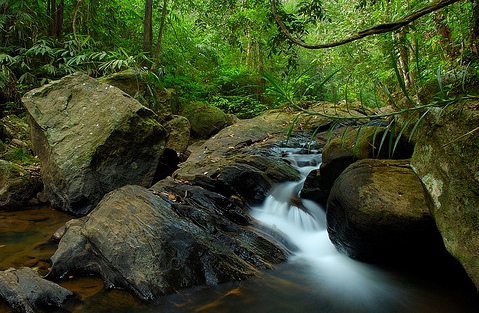Sinharaja Forest
Sinharaja Forest Reserve is a national park and a biodiversity hotspot in Sri Lanka. It is of international significance and has been designated a Biosphere Reserve and World Heritage Site by UNESCO.
The hilly virgin rainforest, part of the Sri Lanka lowland rain forests eco region, was saved from the worst of commercial logging by its inaccessibility, and was designated a World Biosphere Reserve in 1978 and a World Heritage Site in 1988. The reserve's name translates as Kingdom of the Lion.
The reserve is only 21 km (13 mi) from east to west, and a maximum of 7 km (4.3 mi) from north to south, but it is a treasure trove of endemic species, including trees, insects, amphibians, reptiles, birds and mammals.
Because of the dense vegetation, wildlife is not as easily seen as at dry-zone national parks such as Yala. There are about 3 elephants and the 15 or so leopards are rarely seen. The commonest larger mammal is the endemic Purple-faced Languor.
An interesting phenomenon is that birds tend to move in mixed feeding flocks, invariably led by the fearless Greater Racket-tailed Drongo and the noisy Orange-billed Babbler. Of Sri Lanka's 26 endemic birds, the 20 rainforest species all occur here, including the elusive Red-faced Malkoha, Green-billed Coucal and Sri Lanka Blue Magpie.
The hilly virgin rainforest, part of the Sri Lanka lowland rain forests eco region, was saved from the worst of commercial logging by its inaccessibility, and was designated a World Biosphere Reserve in 1978 and a World Heritage Site in 1988. The reserve's name translates as Kingdom of the Lion.
The reserve is only 21 km (13 mi) from east to west, and a maximum of 7 km (4.3 mi) from north to south, but it is a treasure trove of endemic species, including trees, insects, amphibians, reptiles, birds and mammals.
Because of the dense vegetation, wildlife is not as easily seen as at dry-zone national parks such as Yala. There are about 3 elephants and the 15 or so leopards are rarely seen. The commonest larger mammal is the endemic Purple-faced Languor.
An interesting phenomenon is that birds tend to move in mixed feeding flocks, invariably led by the fearless Greater Racket-tailed Drongo and the noisy Orange-billed Babbler. Of Sri Lanka's 26 endemic birds, the 20 rainforest species all occur here, including the elusive Red-faced Malkoha, Green-billed Coucal and Sri Lanka Blue Magpie.
| About Us | Our Services | Sri Lanka | Sri Lanka Hotels | Contact Us | |
| About us | Hotels & Accommodations | About Sri Lanka | 5 Star Hotels | All Hotels in Sri Lanka | Address: |
| Careers | Transport | Sri Lanka Attractions | Beach Hotels | Boutique Hotels | Explore Vacations |
| Contact Us | Airport Services | Sri Lanka Hotels | Bungalows & Villas | Colombo Hotels | No. 371/5, |
| Testimonials | Sri Lanka News and Events | Cultural Area Hotels | East Coast Hotels | Negombo Road, Seeduwa, | |
| Terms & Conditions | Travel Tips | Hill Country Hotels | Ayurvedic Hotels | Sri Lanka. | |
| Privacy Policy | Wildlife & Eco Hotels | Tel: 0094 114 941650 | |||
| Image Gallery | |||||
| Tour Packages: | Email: | ||||
| Hill Country Tour Packages | Leisure Tours Packages | info@lankahotelbooking.com | |||
| Adventure Tours Packages | Wellness Tours Packages | ||||
| Cultural Tours Packages | Honeymoon Tour Packages |
Copyright © 2024 Explore Vacations, all rights reserved. | Web Design and Web Hosting By Webivox Sri Lanka






